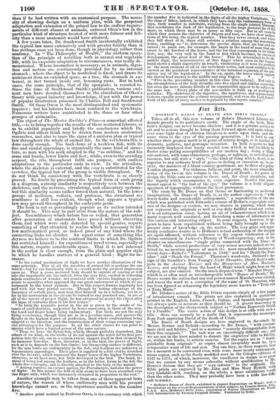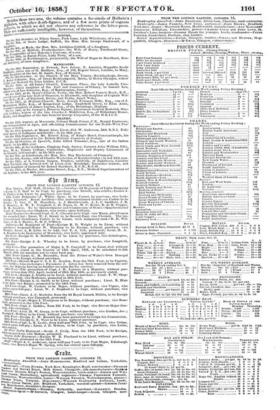lint arts.
HOLBEIN'S DANCE OP DEATH AND BIBLE PRINTS.*
Taken all in all, this new volume of Bohn's Illustrated Library re- dounds greatly to its publisher's credit. The staple of the been, Hol- bein's designs, can never become obsolete ; and it is a genuine service to
art and to serious thought to bring them forward threatens againand again d to saysome light dust of oblivion reatens to settle upon them, and ob-
scure them to the eyes of the passing generation. It is whether their greatest merit is in point of artistic design, or in touches of dramatic, pathetic and grotesque invention. In both respects we find eminently displayed that hardy manful tone which is but too likely to fluster some puling susceptibilities of our modern day ; doing a thing out-and-out, with some clumsiness, perhaps, or ugliness or anti-ideal ob- tuseness, but still with a "style "—the kind of thing which, in art, is as superior to any ordinary level of grace in feeling or execution as, in so- ciety, the manners of a blunt country-gentleman are to those of a polite London shopman. For richness, fullness, and point, the more admirable series of the two in this volume is the Dance of Death ; for power of design the Bible cuts are equal to these, and, for clear simplicity, and
the dignity which accompanies it, even superior. Besides this para- mount appeal to "the lust of the eye," the volume is a truly elegant specimen of typography, without the least pretension.
The essay by Mr. Douce on that theme so fascinating to medieval imaginations, the Dance of Death, is, as the author expresses it, "with fewer faults and considerable enlargement," a reproduction of the one which was published with Edwards's reissue of Holler's copperplate ver- sion of the designs—a version, we may observe in passing, which does not represent the originals so well as any duly faithful wood-cut series.
It is an antiquarian essay, having an air of exhaustiveness which is in many respects well sustained, and furnishing a mine of information on
this curious and interesting subject. In some respects, however, it ap-
pears to have been republished without being fully brought up to the present state of knowledge on the matter. The very grave and appa-
eently conclusive doubts as to Holbein's actual authorship of the designs are again affirmed, without reference to the cogent vindication of his claims contained in Jackson's History of Wood-engraving; and, in the chapter on miscellaneous "single prints connected with the Dance of Death," while several productions of very minor account indeed are re- ferred to, no mention appears of much the most remarkable instance of recent days—Rethel's " Todtentanz in 1848," and his "Death the Pun-
isher" and "Death the Friend." Thurston's wood-cuts, Stothard's de- sign of the Gambler's from Young's Night Thoughts, David Scott's sub-
jects in the Ancient Mariner and the Monograms of Man, Maclise's Lenore, and anything from the hand of Blake which might bear on the subject, are also omitted. On the much disputed term " Macaber Dance"
which is so often used as interchangeable with "Dance of Death," Mr. Douce scouts the notion that any real person named Macaber ever existed, and traces the word to a corruption of the name of St. Macarius, who has been figured as witnessing the legendary Beene known as " Trois vffs et Trois Morts."
Mr. Dibdin's notice of the Bible Prints consists simply of a few pages of introductory remark. The prints are also explained in quotations printed in the English, Latin, French, Italian, and Spanish languages-- not always quite so accurate as they should be. A graver inaccuracy is the description of the thirty-ninth subject as "Nathan Reproveth David
by a Parable." The entire action of this design is at odds with such a title : there can scarcely be a doubt that it represents the messenger from Red) apprizing David of the death of Uriah.
The Dance of Death designs are here engraved in fac-simile by Messrs. Bonner and Byfield—aeeording to Mr. Douce, "with consum- mate skill and fidelity, and in a manner "scarcely distinguishable from their fine originals." The task was an exceedingly difficult one; and we are not in the least minded to dispute the engravers' title to fidelity,
or, within fair limits, to artistic success. Yet the copies are as " distin-
guishable from originals" as copies almost invariably must be, by a comparative want of life and zest. Nor can they, in these respects, bear
for a moment to be contrasted even with some more nearly contempora-
neous copies, such as the freely modified ones in the Cologne editions oft 1557 to 1573; of which, moreover, the excellence in design's so great
that we cannot by any means subscribe without qualification to Yr. Douce'e dictum that they are "very inferior" to the originals. Bible prints are engraved by Mr. John and Miss Mary Byfield, t,n very laudable skill, reaching, on the whole, a more satisfactory re_.1,1',! than the other series. They may probably have been a trifle less dint cult to render. • Holbein's Dance of Death, exhibited in elegant Engravings on Wood ; 111_.2 Dissertation on the several Representations of that subject, by Francis Douce„, F.A.S. Also, Holbein's Bible Cuts, consisting of Ninety Illustrations on 'with Introduction by Thomas Frognall Dibdin. Published by Bohn. Besides tbese two sets, the volume contains a fac-simile of Holbein's shisibet, with other death-figures, and of a few more prints of cognate iu.liects, to which we did not observe any reference in the letter-press. They are sufficiently intelligible, however, of themselves.



























 Previous page
Previous page